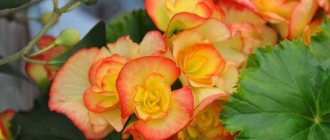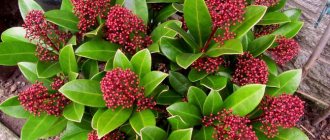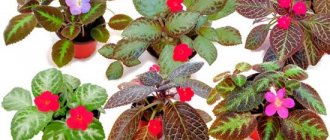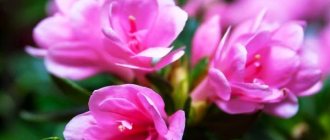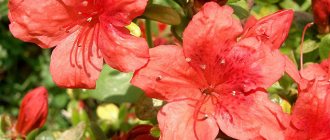Features of care
When you first meet the plant, it is difficult to determine whether wisteria is a tree or a shrub. Neither one nor the other. It is a vine, but it can grow as a shrub or as a tree. Flexible shoots can take any shape, wrap around supports or their own shoots.
Caring for a beauty takes time and patience.
Grows quickly, relying on its own branches, can be formed into a tree
Growing in a comfortable place, wisteria tolerates care and cultivation at home well. Basic requirements for active growth of vines:
- temperature. In the summer, pots with plants are taken out onto the balcony or into the garden. Wisteria can withstand any heat (with the proper level of humidity). In autumn, a period of rest is needed, so for several months the temperature of the exotic should not exceed 10°C. In January, with the awakening of the buds, the flower is gradually accustomed to increased heat and transferred to apartment conditions;
- the plant is light-loving, so only the southern side will provide the amount of light that is necessary for growth and flowering;
- from the beginning of the active growth period - spring, moderate watering is needed, no more than twice a week. In autumn, watering is reduced as much as possible. You need to water the plant along the edge of the pot, without eroding the soil at the base of the shoot and without exposing the roots;
Wisteria bonsai compositions are successful in indoor floriculture.
- in summer, high humidity is maintained by regular spraying of greenery and shoots. During the dormant period, this procedure is not necessary for the flower;
- The soil needs to be light, airy, easily permeable to moisture and air. The nutritional value of the soil should be high. Good soil will be made up of equal parts of turf soil, humus, high peat and river sand;
- During the period of bud formation and flowering, the plant needs additional fertilizing with mineral fertilizers once a week. During the season, the flower is watered with water with the addition of chalk.
General information about the plant
The plant is gaining popularity among landscape designers and gardeners due to the fact that it grows for a long time. This perennial can show off in the garden for up to 150 years. Wisteria requires a certain amount of care and patience. It is recommended to grow the vine on metal, arched or lattice structures.
Wisteria tunnel in Kawachi Fuzi Flower Garden
Do not forget that the wisteria bush has heavy trusses and, thanks to its climbing stem, can cause damage to drains, pipes or trees, as well as destroy fragile arched structures. Therefore, the vine requires care and observation.
This is interesting! In Japan, designers made a tunnel made of wisteria, which attracts many tourists with its beauty.
Beginning gardeners wonder: is wisteria a tree or a shrub? In general, the plant belongs to vines, but indoor wisteria is considered a mini-tree.
Features of winter care
For the full existence of a flower, a dormant period must be organized every year. In the fall, after all the greenery has fallen off, you need to place the pot in a cool room, reduce watering, remove fertilizing and additional moisture.
Ampelous pelargonium or geranium - growing and care at home
If the wisteria bush grows on a glazed balcony, where the temperature in winter does not exceed 10 ° C, it will survive the sleep period there remarkably well.
From the beginning of January, wisteria begins to develop leaf and flower buds. The temperature must be increased gradually. Within two weeks by moving the pot to a warmer room for a while. A sharp change in temperature will destroy the plant.
Important! Without a dormant period, wisteria stops blooming and eventually dies.
Wisteria – photo
All legends about the origin of wisteria are somehow connected with beauty and femininity. You can clearly see that this is not in vain, just by looking at our selection of photographs!
Photo: 1zoom.ru
Photo: womanadvice.ru
Photo: avto.goodfon.ru
Photo: artfile.ru
Photo: oir.mobi
Photo: getwallpapers.com
Photo: 999.md
Photo: badfon.ru
Photo: sibcvetok.ru
Photo: phonoteka.org
Photo: maxpark.com
Photo: oir.mobi
Photo: nevseoboi.com.ua Photo: pulse.mail.ru Photo: 1zoom.ru
Photo: w-dog.ru
Photo: liveinternet.ru
Photo: youtube.com
Photo: dachnaya-zhizn.ru Photo: artmaki.su
Photo: kuban.mk.ru
Photo: oir.mobi
Photo: oir.mobi
Photo: wallpapercave.com
Photo: 1zoom.ru
Photo: avto.goodfon.ru
Photo: w-dog.ru
Photo: oir.mobi
Photo: pinterest.at
Photo: pinterest.ru
Photo: flo.discus-club.ru
Did you like the post? Subscribe to our channel in Yandex.Zen, it really helps us in our development!
When and how does wisteria bloom?
Dipladenia (Mandevilla) - growing and care at home
The liana begins to throw out flower stalks in March-April when it awakens correctly. Flowering lasts from two weeks to two months. It all depends on the variety and conditions of detention. The shape of the flowers corresponds to the legume family, to which wisteria belongs.
Long brushes strewn with small purple flowers
The palette of wisteria is not too large: pink, blue, white or lilac waterfalls. To maintain active flowering, regular mineral feeding is needed.
Types of wisteria
There are nine main types of wisteria, but only three are used for decorative purposes in landscape design. Violet and lilac shades are more common, although there are white, blue and pink.
Wisteria lushflower
A large vine stretches up to 15 m and is dotted with large snow-white or blue-purple tassels. Its main advantage is its amazing frost resistance down to -40 degrees.
Photo: wallpapercave.com
Wisteria multiflorum
This wisteria is more compact and more reminiscent of a tree with its woody shoots. Its brushes are even larger - up to 60 cm, but the leaves are also large. Mostly multi-flowered varieties are colored blue or pale purple.
Photo: flo.discus-club.ru
Chinese wisteria
A large woody vine quickly entwines the most complex and large supports, which is why it is valued in landscape design. Chinese wisteria is thermophilic, but can withstand short frosts down to -20 degrees. It is from this species that almost all decorative hybrids originated - Alba, Blue Sapphire, Plena, Sierra Madre.
Photo: na-dache.pro
Blueberry Patriot: variety description, care and planting
Trimming
Fuchsia growing and care at home
Stimulate flowering and growth by pruning. After flowering, the shoots are cut back by two-thirds, and in February-March - to 2-3 good buds.
If wisteria is given the shape of a trunk, you need to leave one or several powerful shoots, removing all lateral and basal shoots
When growing as a vine or bush, part of the side shoots must be cut off so that the flower does not waste energy on them.
Important! In too branched areas of the shoot, flowering will be rare.
Appearance and other characteristics
Wisteria is a type of vine. The trunk begins to branch at the very base; a year is enough for the shoots to become woody. The shoots are first covered with smooth, light olive-colored bark, and then brown with large grooves. The length of wisteria reaches two tens of meters.
On young seedlings, petiolate foliage grows, which has an asymmetrical shape. The length of one such leaf can reach 30 cm. It consists of 7-13 parts. Their shape is oval, the edges are smooth, and the end is pointed. On older shoots, the leaves immediately appear dark green with short pile on the surface, but gradually this pile disappears.
Some types of wisteria bloom before the foliage appears, although the leaves usually appear first. If favorable conditions are provided for the plant, it can bloom up to three times a year.
The flower stalks of wisteria are long and covered with small flowers. The structure is typical for all plants belonging to this family. Externally, the inflorescence resembles a garland.
The color of the flowers can vary from blue to purple, but there are varieties with white, pinkish, and yellow flowers.
Insects are needed for pollination, after which the fruits ripen (these are beans), which may have a dark gray color. There are also dark-colored seeds inside.
Reproduction
To grow a new plant, you need to choose one of the following methods:
- seeds. Seeds that have previously hatched on damp gauze are sown in January in moist soil (the mixture is the same as for an adult plant). The container is covered with film or covered with glass. The soil temperature should not be lower than 23°C. After the sprouts appear, you need to slowly harden them without film and expose them to the sun. The seedlings are ready for planting in separate pots when two true leaves appear on them. Wisteria obtained from seeds is unlikely to bloom;
- propagation by cuttings is the most reliable and fastest way. Shoots 20 cm long are cut obliquely 2 cm below the last leaf bud. Root while maintaining soil moisture. It is also necessary to observe the temperature regime, as when growing seeds;
Wisteria seeds
- It is convenient for garden wisteria to reproduce by layering. If you grow it in an apartment as a vine, you can also use this method. You need to make a cut on the layering and dig it into a new pot with soil. Care for an adult plant and after a month you can check for root formation;
- It is difficult to propagate by grafting cuttings to the root system. Experienced wisteria breeders do this and most often for the garden option of breeding these magnificent vines.
Sections of one-year-old shoots are suitable for cuttings
Pest and disease control
Wisteria is quite resistant to pests, but it is unlikely to be able to avoid aphids and clover mites. For treatment, acaricides and insecticides are used prophylactically and as needed. The most common disease is leaf chlorosis, which is usually caused by alkaline soil.
Photo: pxhere.com
Hydrangea (80 photos): types and features of care
Possible problems in growing wisteria
During cultivation, flower growers may encounter the following difficulties:
With proper care, a lilac waterfall will become an object of admiration for many years
- lack of flowering. If the plant is well cared for and does not bloom, it means it is growing in a pot that is too spacious. With a large volume of soil, the flower will only grow its root system and greenery;
- During flowering, leaves may begin to fall abundantly. This is a sign of nutrient deficiency. More nutritious soil and fertilizing are needed;
- If the soil contains a large amount of alkali, the leaves may begin to turn yellow. This is chlorosis. Mineral fertilization of the soil will help.
Wisteria is a magnificent decoration for both the garden and the home. She will definitely make up for all the time spent on care with her beauty. In regions such as Siberia, growing a garden version will not work, so indoor wisteria is an excellent solution.
Leningrad and Rostov regions
Many gardeners select a Chinese or multi-flowered variety to grow and care for wisteria in the Leningrad region. Unfortunately, this is completely unacceptable for this area. As a rule, the plant dies. Even if it is possible to grow a vine, its flowering will be very sparse - just a couple of frail inflorescences.
It is best to give preference to a hybrid variety characterized by high frost resistance - “Blue Moon”. This is a large-tasseled variety that will not only develop well, but will also produce excellent flowering. Planting is carried out with seedlings, planting in the ground with the onset of June. To prevent the plant from dying in winter, before frost, the vine should be carefully removed from its supports and thoroughly insulated with lutrasil. They do the same when planting and caring for wisteria in the Rostov region.
Varieties
There are nine types of wisteria, differing in the shade of the flowers, the shape of the crown, and the characteristics of agricultural technology.
Chinese
One of the popular species, which has flowers of different shades, from white to purple. The foliage is dense, long, dense. Flowering begins in May. With good care, it can be repeated in early autumn. Lianas reach a height of 25 meters.
profusely blooming
Her height is less than the Chinese one (about 10 meters). The leaves are large, complex, consisting of 19 leaves. The flowers are small, blue, the buds bloom alternately. Abundantly flowering wisteria is frost-resistant (down to -24 ⁰C). The inflorescences and fruits look very impressive.
Shrub
The height of the vine reaches 15 m. The stems are powerful and heavy. It blooms starting in May with small, fragrant inflorescences for about 4 weeks. At the end of flowering, seed pods appear. The leaves have up to 15 segments and bloom along with the flowers.
Coarse cystic
This species is native to North America. Flower brushes can reach one and a half meters in length. The growth of the vine is 12 meters. It is characterized by high winter hardiness.
Frost-resistant
Wisteria varieties that can withstand temperatures down to -40 ⁰C were bred in the USA, from where they were brought to the Russian Federation. The maximum height of an ornamental shrub is 7-8 meters. The varieties have a highly developed root system.
Silky
A type of wisteria with short inflorescences (15 cm), short height (about 5 meters) and a strong aroma. The liana blooms in late spring with purple inflorescences with a white spot. Silky wisteria is suitable for decorating walls and gazebos.
Japanese
Fragrant flowers appear on the vine first (in April), and later foliage appears. Plant height up to 20 meters. The seasonal growth of shoots is 20 cm.
Combinations in garden design
The appearance of wisteria is very impressive. It looks great both in individual and group plantings. Other flowering garden plants can emphasize the beauty and unusualness of the vine.
Tulips
The flowering periods of wisteria and tulips coincide. A composition of a large number of red buds against a green lawn is set off by the delicate colors of wisteria. Elements made of natural stone, a forged fence or a support for a vine can be a good addition.
Daffodils
White and yellow daffodils can be placed in flowerpots under wisteria vines in early spring. containers, pots. After flowering ends, they have a slightly sloppy appearance. By removing containers, you can avoid making daffodils unattractive.
Hyacinths
These bulbous plants are classified as primroses. Combined with tulips and daffodils, they create a wonderful backdrop for wisteria. Dark purple hyacinths look especially impressive, having a brighter shade than the blue brushes that bloom on the vines.
Muscari
To combine with wisteria, you can choose muscari with all shades of blue. They are planted under the standard forms of plants, in a circle around the trunk.
Imperial hazel grouse
The different heights of the flowers, from 10 cm to 120 cm, allow the imperial hazel grouse to be used both for individual plantings and in the shade of wisteria. They look good at the entrance to a gazebo, near a pond, or in a rock garden.
Hibiscus
The plant looks great in a shrub border next to low-growing wisteria. It is worth supplementing the composition with evergreens.
Purslane
Due to the fact that purslane has a rich color palette, it is customary to decorate the space near paths with them. They look very advantageous as a lower tier under cascading wisteria tassels.
Platycodon grandiflora
The plant is decorative not only during flowering, but also in the fall due to its beautiful foliage. For rocky soil under wisteria, dwarf varieties of Platycodon are chosen, which are planted together with coniferous crops.
Belarus and Ukraine
These countries are in a much warmer climate than in central Russia. So summer residents can rejoice - they will be able to grow wisteria. Moreover, they can grow heat-loving varieties, for example, “Chinese”.
When growing wisteria in Belarus, they give preference to seedlings. At one year of age, they are planted in a sunny area when the soil and environment are well warmed up. This time comes in April-May. Mature vines will flower during the summer months, starting in late June. With the arrival of autumn, the plant should be well insulated.
Rules for planting and care in open ground
Wisteria prefers to grow in subtropical conditions. It is possible to grow it in latitudes located north of the Caucasus, Stavropol, and Crimea, but it will not be possible to achieve abundant flowering. For the middle zone, breeders have developed frost-resistant varieties intended for temperate climates.
Recommendations for choosing deadlines
Most often, wisteria is grown from ready-made seedlings, which are placed in a permanent place in open ground in the spring, when the frosts have ended. Although most varieties of perennial vines are winter-hardy, young plants should not be risked.
Selection and preparation of a site
The place for planting wisteria is carefully chosen, since it is assigned there for many years. It should be illuminated by the sun and be closed from drafts. Fertile, well-drained, slightly alkaline soil rich in nutrients promotes long-term flowering of wisteria. Before planting, the soil is carefully dug up, weeds are removed, mineral fertilizers are added, and holes are prepared for the seedlings.
Planting scheme
After the soil for planting wisteria has been prepared, the plant is planted according to the following scheme:
- Dig holes 70 cm x 70 cm x 60 cm.
- Drainage is placed at the bottom.
- Pour soil with mineral fertilizers into the hole.
- Place the seedling strictly vertically.
- The voids are filled in so that the growth point remains above the soil surface.
- Water with warm, settled water.
- Mulch the tree trunk circle with peat or grass.
When planting wisteria, you should leave a gap of at least 30 cm between it, the support or other plants.
Watering mode
Wisteria prefers moderate irrigation. It feels bad both in waterlogged and too dry soil. It is enough to water the plants once every 7 days in a volume of 10 liters per bush. Additional moisture is required during the budding period to prevent future flowers from falling off. Starting in autumn, watering is reduced.
Spraying
Watering wisteria can be alternated with spraying its crown. To prevent the roots from rotting due to stagnation of water, in hot weather you can lightly sprinkle and spray the foliage instead of intensively moistening the root system.
Top dressing
To maintain the flowering of wisteria, it is fed weekly. Complex fertilizers and organic matter help restore the strength of the vine, which can increase its length by three meters per season.
Trimming
It takes about three years for the main branches of wisteria to form. After the “skeleton” is formed, excess shoots are cut out annually to allow lateral shoots to grow, where flower buds are formed. In order to rejuvenate the vines, it is recommended to remove one shoot annually, sending a new, young one in its place for replacement.
Summer
The main shoot of wisteria in the summer of the first year is cut to a highly developed bud, and the short side shoots are left. In the second year of life, the main shoot of the vine is pinched again, and the side branches are shortened to the length of the main stem. Another year later, in the summer, the shoots are cut by a third so that the crown becomes denser, and the lower side shoots are removed completely.
Winter
In winter, the main and other shoots that grew after summer pruning are shortened. The previously cut branches are shortened by one third. Side shoots are cut to three buds. In the second and third years, winter pruning is carried out in the same way.
Preparing for winter
Covering wisteria for the winter begins with the onset of the first frost. Its roots are carefully earthed up, insulated with mulching, the vine is removed from its support, laid on boards, covered with spruce branches, dry leaves or straw, and covered with covering material on top. In winters with little snow, they are additionally covered with agrofibre.
Wisteria blooms for the first time at the age of three years. The first buds appear in May. They are collected in large inflorescences up to 35 cm long. In the southern regions, flowering can be repeated up to three times. To prevent the plant from losing its strength to form fruits, it is recommended to remove wilted flowers.
Pests
The most harmful enemies of wisteria are clover mites and aphids .
Aphid
If the leaves begin to dry, the branches become distorted, the flowers become smaller, and the plant withers, it means that the wisteria has been attacked by a colony of aphids.
get rid of these small parasites using one of the modern insecticides: Fitoverm, Karate, Intavir, Actellik.
Clover mite
A small parasite with an oval body of inconspicuous green or brown color. It is very difficult to notice - the body length barely reaches 0.4 mm. An attack can be detected by characteristic external signs.
The surface of the leaves becomes covered with small light streaks, then cracks. Affected leaves become twisted.
work great against mites , completely ridding the plant of parasites. You can use Nissoran, Sunmite, Apollo, Fitoverm, Oberon, Omite.
Wisteria is rarely grown as a houseplant, as it requires special conditions. It is not suitable for beginner flower growers and people with an acute lack of time.
